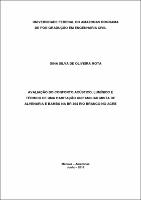| ???jsp.display-item.social.title??? |


|
Please use this identifier to cite or link to this item:
https://tede.ufam.edu.br/handle/tede/7164| ???metadata.dc.type???: | Dissertação |
| Title: | Avaliação do conforto acústico, lumínico e térmico de uma habitação unifamiliar mista de alvenaria e bambu na BR 364 Rio Branco no Acre |
| ???metadata.dc.creator???: | Mota, Gina Silva de Oliveira  |
| ???metadata.dc.contributor.advisor1???: | Vasconcelos, Raimundo Pereira de |
| ???metadata.dc.contributor.referee1???: | Araújo, Valdete Santos de |
| ???metadata.dc.contributor.referee2???: | Correa, Ana Cristina Santos Strava |
| ???metadata.dc.description.resumo???: | A habitação unifamiliar em relação às questões sociais permanece como prioridade devido a deficiência em suprir as necessidades de moradia no Brasil. Na região de Rio Branco, Acre, uma alternativa sustentável é o bambu como material principal a ser utilizado na construção civil. Grandes são os desafios a serem superados, mesmo transpondo dificuldades na descoberta de novos caminhos, onde a visão do agora e do futuro é reunir a matéria prima de uma maneira comprovadamente sustentável, confortável, de fácil acesso, com poucos recursos, manuseio com ferramentas simples, produto durável, renovável e esteticamente aceitável. Desta forma, o Bambu se apresenta como um material com estas características, sendo um vegetal altamente resistente a ponto de ser utilizado na construção de uma habitação unifamiliar, pois é um recurso natural abundante na região norte, e que conta com vários estudos que apontam para o uso desse tipo de material em construções. Para reforçar esses estudos este trabalho se propôs a avaliar o conforto térmico, acústico e lumínico de uma habitação unifamiliar construída com alvenaria e bambu na BR 364 em Rio Branco – Acre. A construção analisada apresentou desempenho inadequado para o conforto térmico, onde na pior situação, o Dormitório I apresentou valor superior a 20% em relação ao limite da norma. Mesmo no pavimento superior, construído com bambu, o valor médio ainda é bem superior ao limite, aproximadamente 18%. Os resultados acerca do desempenho em termos de conforto, lumínico e acústico, se apresentaram dentro dos limites estabelecidos pelas normas da ABNT. |
| Abstract: | Single family house in relation to social issues remains as a priority due to failure to meet the needs of housing in Brazil. In the region of Rio Branco, Acre, a sustainable alternative is the bamboo as the main material to be used in civil construction Great are the challenges to be overcome, even transposing difficulties in finding new paths, where the vision now and in the future is to gather the raw material in a way that demonstrably sustainable, comfortable, easy access, with few resources, handling with simple tools, product durable, renewable and aesthetically acceptable. In this way, the Bamboo presents itself as a material with these characteristics, being a plant highly resistant to the point of being used in the construction of a single-family house, because it is a natural resource abundant in the north region, and that counts with several studies that point to the use of this kind of material in construction. To reinforce these studies this study proposes to evaluate the thermal comfort, acoustic and luminous of a single-family house constructed with masonry and bamboo on the BR 364 in Rio Branco, Acre. The construction analyzed presented inadequate performance for thermal comfort, where in the worst situation, the bedroom I presented a value greater than 20% in relation to the boundary of the standard. Even on the upper floor, built with bamboo, the average value is still well above the limit, approximately 18%. Results about the performance in terms of comfort, luminous and acoustic, presented within the limits established by the ABNT standards. |
| Keywords: | Bambu Sustentabilidade Economia Habitação alternativa |
| ???metadata.dc.subject.cnpq???: | ENGENHARIAS: ENGENHARIA CIVIL: CONSTRUÇÃO CIVIL: MATERIAIS E COMPONENTES DE CONSTRUÇÃO |
| Language: | por |
| ???metadata.dc.publisher.country???: | Brasil |
| Publisher: | Universidade Federal do Amazonas |
| ???metadata.dc.publisher.initials???: | UFAM |
| ???metadata.dc.publisher.department???: | Faculdade de Tecnologia |
| ???metadata.dc.publisher.program???: | Programa de Pós-graduação em Engenharia Civil |
| Citation: | MOTA, Gina Silva de Oliveira. Avaliação do conforto acústico, lumínico e térmico de uma habitação unifamiliar mista de alvenaria e bambu na BR 364 Rio Branco no Acre. 2018. 127 f. Dissertação (Mestrado em Engenharia Civil) - Universidade Federal do Amazonas, Manaus, 2018. |
| ???metadata.dc.rights???: | Acesso Aberto |
| ???metadata.dc.rights.uri???: | http://creativecommons.org/licenses/by-nc-nd/4.0/ |
| URI: | https://tede.ufam.edu.br/handle/tede/7164 |
| Issue Date: | 15-Jun-2018 |
| Appears in Collections: | Mestrado em Engenharia Civil |
Files in This Item:
| File | Description | Size | Format | |
|---|---|---|---|---|
| Dissertação_GinaMota_PPGEC.pdf | 3.16 MB | Adobe PDF |  Download/Open Preview |
This item is licensed under a Creative Commons License





